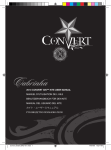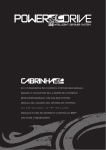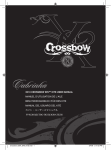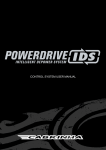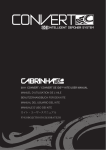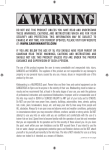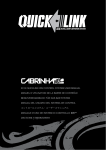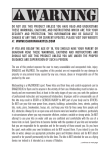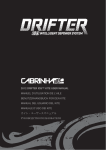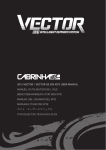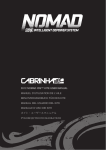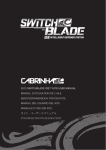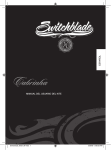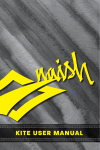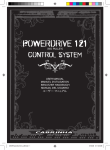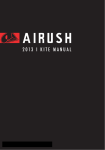Download pause! - Cabrinha
Transcript
Powerdrive_IDSX_ENG_final.indd 1 28/3/09 5:49:07 PM DO NOT USE THIS PRODUCT UNLESS YOU HAVE READ AND UNDERSTAND THESE WARNINGS, CAUTIONS, AND INSTRUCTIONS WHICH ARE FOR YOUR SECURITY AND PROTECTION. THIS INFORMATION MAY BE SUBJECT TO CHANGE AT ANY TIME. FOR CURRENT UPDATES, PLEASE VISIT OUR WEBSITE AT: WWW.CABRINHAKITES.COM IF YOU ARE BELOW THE AGE OF 18, YOU SHOULD HAVE YOUR PARENT OR GUARDIAN READ THESE WARNINGS, CAUTIONS AND INSTRUCTIONS AND SHOULD NOT USE THIS PRODUCT UNLESS YOU ARE UNDER THE PROPER GUIDANCE AND SUPERVISION OF SUCH A PERSON. The use of this product exposes the user to many unavoidable and unexpected risks, injury, dangers and hazards. The suppliers of this product are not responsible for any damage to property or any personal injury caused by any use, misuse, abuse or irresponsible use of this product by the user. Kiteboarding is a hazardous sport. Power kites and their lines and control equipment can be dangerous to flyers and to anyone in the vicinity of their use. Kiteboarding must be taken seriously and we recommend that, at least in the early stages of your use, you seek the guidance of professional instructors and experienced kiteboarders. Improper and/or unreasonable use of this kite may result in death or serious injury to any part of your body and to others. Do not use your kite near power lines, airports, buildings, automobiles, trees, streets, etc. and keep your kite fly lines away from people and all obstacles. Always fly in an open area and observe wind and weather conditions, particularly in circumstances where you may encounter offshore, onshore winds or strong winds. Do not attempt to use your kite on water until you are confident and comfortable with the use of a trainer kite on land. Spend time to become familiar with the operation of your kite and remember that you are responsible for its operation and for the security of those around you. As you learn the sport, work within your own limitations and do not exceed them. If you intend to use the kite on water, always use appropriate protective gears and flotation devices and do not attach yourself or tie yourself permanently to the kite lines. The kite is not intended for use as a flying device nor indeed is it intended as a means of flotation. ...continues to next page Powerdrive_IDSX_ENG_final.indd 3 28/3/09 5:49:07 PM continued from previous page... RECOMMENDED KITEBOARDING PRACTICE: Kiteboarding is an extremely diverse sport, with many disciplines and ability levels. As with all sports, there can be certain inherent risks. The following contains key security points to remember when operating your Cabrinha kite. • Kiteboarding is a HAZARDOUS activity and the use of Kiteboarding equipment involves the risk of serious personal injury to any part of the user’s body or death. • Injuries are an INHERENT RISK of kiteboarding and the participation in kiteboarding implies the user’s acceptance and assumption of those risks. • Children should always be under adult supervision. • It is strongly recommended that beginners take lessons. • ALWAYS inspect your equipment for signs of wear and tear each time before use, particularly all lines, canopy, bladders, screws and fittings. • IF any products are found to show signs of wear & tear these should be repaired or replaced immediately and before further use. If in doubt about any signs of wear & tear, please contact your local vendor. Contact details are available from www.cabrinhakites.com • NEVER place yourself in a situation where breakage of any one of the various kiteboarding components would pose a risk to yourself or others, or make it difficult to return to the shore securely & unassisted. • Make sure you use properly designed and manufactured parts from reputable suppliers. • Take time to study the conditions including sea state, tides, currents, weather conditions and forecasts before you decide to go sailing. Beware of sailing in offshore, onshore or strong winds. • Familiarize yourself with any new location before venturing onto the water. Ask the locals to tell you about any hazards. • Watch out for other beach users, especially swimmers and small children. Make sure you keep your board and rig under control at all times and that they don’t get blown about on the beach or in the water. • Always use appropriate protective gear and flotation devices. Wear the correct protective clothing for the conditions such as a wetsuit or a UV top. It is recommended to wear a helmet. • Make sure someone knows where you’ve gone & when you are expected back – always sail with a buddy. • Be aware of the conditions as they change. Always return to the beach if there is a significant change in the conditions. i.e. wind dropping or wind & waves increasing. • As you learn the sport, work within your own limitations and do not exceed them. • Do not alter, modify or change this product. • This product is designed and manufactured only for kiteboarding on water or snow. • Keep these warnings, cautions and instructions for future reference. • The following contains key security points to remember when operating your Cabrinha kite, and associated kiteboarding equipment on water, land or snow Powerdrive_IDSX_ENG_final.indd 4 28/3/09 5:49:08 PM SNOW USE GENERAL GUIDELINES • The points listed under the Recommended Kiteboarding Practice also apply to the use of this product on the snow. Please read the previous paragraphs even if you intend to use this product primarily on the snow. • These kites are intended for use on the snow as a traction device to propel a rider across wide open snow fields in a controlled and appropriate manner. • Do not attempt to use this kite as a flying device. Do not use this kite to soar from ridges, cliffs or slopes. • Do not attempt to launch yourself into the air in any manner which can create excessive impact to the rider upon landing. • Extreme caution must be taken when using this kite in any mountainous region, uneven terrain or glacier. Wind conditions in these areas are notoriously unstable and can change in velocity and direction without notice. • Never use this product in the vicinity of powerlines, liftlines, trees, or other obstacles. Contact with these obstacles can cause severe injury or death. • Do not tether yourself to any stationary or moving object such as a stake, snowmobile, or car while flying this kite. • Always stay in control and be able to stop or avoid other people or objects • SNOWKITE: People downwind or down slope have right of way. It is your responsibility to avoid them • SNOWBOARD: People down slope have right of way. It is your responsibility to avoid them • You must not stop where you obstruct others or are not visible. • Whenever starting or merging with others look upwind/up hill and yield to others. • Always use devices to help prevent runaway equipment. • Observe any and all posted signs and warnings • Keep out of closed areas • SNOWBOARD: Prior to using any lift you must have the knowledge and ability to load, ride and unload safely. • Do not snowboard/snowkite when tired or under the influence of alcohol or drugs. • Snow terrain and snowboarding/snowkiting conditions vary constantly--watch out for and avoid any man made structures, trees, rocks, debris, variations in terrain or slopes, avalanche areas, crevasse, cliffs, power lines, water hazards, changes in snow surfaces or texture due to altitude and sun exposure, wind and weather changes, and any other conditions which could affect your ability to properly control your snowboard/snowkite. Powerdrive_IDSX_ENG_final.indd 5 28/3/09 5:49:08 PM CONTENTS 2010 POWERDRIVE IDS 2 3 4 5 6 7 8 9 Introduction ImportantInformation Wind,Water,&WeatherConditions KnowYourAbilityLevel/KiteboardingLocation KiteCare BeachEtiquette AreaofOperation KitePositions,Zone&Power CONTROL SYSTEM OVERVIEW 10 2010POWERDRIVEIDS™ SETUP 11 LineLengthCorrections 13 DownwindLaunchSetup 14 UpwindLaunchSetup OPERATION 15 QuickReleaseSystem 16 SecurityPin 17 BYPASS™Leash 18 OverSlide™ 19 CenterlineAdjustmentStrap 19 SwivelMaintenance 20 22 IDS™LandingLine Steering 23 24 25 26 27 28 PAUSE Launching Landing Relaunching Tuning Glossary 2010POWERDRIVEIDSCONTROLSYSTEMUSERMANUAL Powerdrive_IDSX_ENG_final.indd 1 1 28/3/09 5:49:10 PM INTRODUCTION Thank you for purchasing this Cabrinha product and welcome to the sport of kiteboarding. As you may know, the excitement of Kiteboarding is attracting people of all ages from all corners of the globe. It’s one of the most dynamic and fastest growing sports in the world. CAUTION: Kiteboarding can be overwhelming if not approached in an educated manner. That’s why we have supplied this extensive user’s manual. It will help to educate you about your new kite and about the ways in which to use it. It contains information regarding the setup, care and maintenance of your control system. Please note that only compatible Cabrinha kites will benefit from all of the security and performance functions associated with this control system. Consult www.cabrinhakites.com for a list of compatible kites for use with this control system. Please read this user’s manual carefully and entirely before using this control system. This manual is not intended to replace proper kiteboarding instruction, but rather to supplement it. Do not attempt to kiteboard without appropriate instruction. It will make this sport more enjoyable, not only for yourself, but for those around you. 2010 POWERDRIVE IDS CONTROL SYSTEM USER MANUAL Powerdrive_IDSX_ENG_final.indd 2 28/3/09 5:49:12 PM IMPORTANT INFORMATION Kiteboarding is a hazardous sport, with many disciplines and ability levels. As with all sports, there are inherent risks of injury. The following contains key points to remember when operating your Cabrinha kite. • Be familiar with the set up and use of the supplied security systems: IDS Landing Line, and the Harness Loop Quick Release systems. • Make sure your Powerdrive IDS™ control system is rigged and used according to the supplied instructions. • Make sure your kite is compatible with the Powerdrive IDS™ control system . • Always use your Cabrinha kite with a Bypass™ leash. • NEVER permanently attach yourself to this kite, the control bar, or lines. • NEVER use this kite as a flying device. • NEVER touch the kite lines while they are under tension; do not catch the kite using these lines. • When inflated but not in use, secure your kite with sand or with something heavy and nonabrasive; the more weight the better (see “Kite Care” for more information). An inflatable power kite will still fly, even without a rider, so be mindful of those around you and secure your kite. Your kite may cause serious injury or death if it launches unexpectedly. • Do not lend your gear to someone who has not been fully instructed on the use of inflatable kites. Other users should also read this user’s manual and be proficient in all its points. • Check your gear before going on the water. Insure that your flying lines, security systems, kite, board, etc. are all rigged properly and are in working order. PROTECTIVE GEAR We strongly recommend the use of the following protective gear: • Helmet • Life Jacket, Impact Vest, or Flotation Vest • Neoprene Wet Suit • Gloves • Foot Protection • Eye Protection • Knife • Sunscreen 2010 POWERDRIVE IDS CONTROL SYSTEM USER MANUAL Powerdrive_IDSX_ENG_final.indd 3 28/3/09 5:49:12 PM IMPORTANT INFORMATION WIND, WATER, AND WEATHER CONDITIONS • • • • • • • • • • • • Do not underestimate the power of the wind. Be aware of unpredictable and changing weather conditions. Avoid “offshore” or “onshore” wind conditions. Avoid strong, gusty wind. Be careful of wave conditions, especially when learning. Be educated about tides and rip currents. Be mindful of your ability level. Do not kiteboard if conditions are beyond your ability level. Be educated about air and water temperatures and wear appropriate protection against the elements. Do not use this product in thunderstorms. Consult an anemometer to determine wind speeds if necessary. Do not use an oversized kite. Consult your Wind Range Chart for the correct recommended size. Use your common sense. If in doubt about what kite size to use, choose smaller rather than bigger. Make certain that you are physically capable of operating the security Quick Release (QR) and IDS™ devices provided with this kite. This kite and control system has been designed around a typical rider weight of 75kg. Riders with a weight greater than 75kg may need to use more force to operate the QR than lighter riders. Increases in wind strength may also result in greater force being required to operate the QR. Be certain to seek the advice of a professional such as your Authorized Cabrinha Dealer about the performance of the security systems in relation to body weight. 2010 POWERDRIVE IDS CONTROL SYSTEM USER MANUAL Powerdrive_IDSX_ENG_final.indd 4 28/3/09 5:49:13 PM IMPORTANT INFORMATION KNOW YOUR ABILITY LEVEL KITEBOARDING LOCATION • Do not attempt kiteboarding without appropriate instruction. • Observe local laws and regulations regarding this product and the usage area. • Do not kite alone. • Talk to the local riders about the weather conditions and beach rules. • Launch, land, and ride together with a partner or have someone on shore who can keep an eye on you. • Make sure you are in good physical condition before using this product. • Practice flying a small, traction kite or a “trainer kite” before flying this kite. • The more time spent on the “trainer kite”, the faster you will learn. • Make sure you are a proficient swimmer before using this product in or near the water. • Make sure the wind and water conditions are within your ability level and that you have made the correct equipment choices. • Never kiteboard further from shore than you are reasonably able to swim back. • Always save a reserve of energy; end your kiteboarding session before you are exhausted. • Make sure you’ve done your homework and that you know the security precautions of all aspects of the sport: rigging, launching, landing, flying, riding, kiting among other water users, self rescuing, practice. • Understand and practie operating your security systems before ever launching your kite. • Understand the technique of self-rescue before using this product in or near the water. • Never let someone who is not familiar with inflatable kites launch, catch, or use your kite. You will endanger them, as well as yourself and those around you. • Check your area thoroughly before launching your kite. • Make sure you have considerable space in which to launch, land, and use this product. • You should have at least 100 meters of space from all objects on both sides and downwind of you. Be especially aware of your downwind area. • Be mindful and aware of the wind direction in relation to your launch area. • Avoid areas with rocks and/or shallow or exposed reefs. • Be mindful of tide changes. As water levels change, you may be exposed to new obstructions. • Avoid launching, landing or using this product near power lines, telephone poles, trees, people, pets, buildings, automobiles, streets, sharp objects and airports. • Avoid crowded beaches and waterways. • Make sure your lines do not cross a walkway or passage. • Do not let others walk between you and your kite. • Be careful and mindful of other water users, including windsurfers, boaters, jet skiers, swimmers, floating objects, etc. • Before launching, make sure you have scouted a backup landing area, in case you do not make it back to your launch spot. • You are responsible for the proper operation of your kite. 2010 POWERDRIVE IDS CONTROL SYSTEM USER MANUAL Powerdrive_IDSX_ENG_final.indd 5 28/3/09 5:49:13 PM IMPORTANT INFORMATION KITE CARE Due to the often extreme nature of kiteboarding, a thorough approach should be taken when caring for your kite and all its associated rigging, as well as your protective gear. PREPARING FOR YOUR SESSION • Thoroughly check your protective equipment (helmet, etc.) to make sure it is in working order and in good condition. • A frequent inspection of the kite and the control system should be made in order to identify punctures, tears, or abrasions in the canopy, struts, or security systems. It is also necessary to check the fly lines for wear and for unwanted knots, which may reduce the strength of the fly lines. Check bridle lines and pulleys for wear and replace when necessary. • Do not rig on asphalt, cement, gravel, or other abrasive surfaces; doing so may damage your equipment. It is best to rig on sand or grass. Damage done to your equipment by rigging on abrasive surfaces will not be covered under warranty. near the trailing edge to minimize or stop the fluttering • Do not leave your kite exposed to sunlight for long periods of time. Between sessions, choose a shaded area to secure your kite. When not in use, stow away. • When not in use, release the Tension Ring from the OverSlide IDS unit. This will help prevent excessive wear on the depower mainline. PROPER STORAGE • It is recommended to wash your kite with fresh water and dry thoroughly before rolling and storing. • Do not roll up kite when wet. • Clear the kite of sand or other foreign objects before stowing. • Do not rig among sharp objects that could tear the canopy or puncture the struts and leading edge bladder. • Once it is clean and dry, stow your kite in the supplied bag in a clean, dry, cool place. • Take care not to expose your flying lines to sharp objects that may wear through them. • Do not place heavy objects on the bag containing the kite. • While setting up, secure your kite with sand or sand bags. Do not secure your kite with rocks or other sharp or abrasive objects that may damage your kite. • Do not leave your kite inflated in your car or car rack box; exposing the kite to extreme temperatures while inflated may damage the internal bladders. BETWEEN SESSIONS • Never leave an inflated kite unattended on the beach for a long period of time. Winds may shift or change and the kite may become unsecured and fly off. • Wash your control system with fresh water from time to time by placing the entire control system (with lines wound onto the bar) into a bucket of fresh water and let it sit for 5 minutes. Allow to dry thoroughly before storing in a dry location. • Do not leave an inflated kite (secured or not), directly exposed to the wind for any length of time. This allows the trailing edge to flutter excessively, which can damage the kite or tangle the bridles/control lines. If you must leave the kite exposed to the wind on the beach, place sufficient amounts of sand between each strut and • Once it is clean and dry, stow your control bar in the supplied bag in a clean, dry, cool place. • Be sure that the Tension Ring is fully disengaged from the OverSlide IDS unit. This will allow fresh water to pass between and flush these smaller parts. It will also help to prevent excessive wear on the depower mainline. 2010 POWERDRIVE IDS CONTROL SYSTEM USER MANUAL Powerdrive_IDSX_ENG_final.indd 6 28/3/09 5:49:13 PM Beach etiquette Here are some basic things to consider when sharing beaches and water accesses with other users: SAFETY • Follow the instructions outlined in this manual. • Follow the instructions and rules and regulations posted at the beaches you use. • Check with local kiteboarding associations and shops prior to launching in a new area. There may be local rules and regulations to follow which are not posted. • Utilize common sense. • Do not touch other people’s gear, unless instructed to do so by the owner. Picking up their bars, kites, etc. may disrupt a setup ritual they have. • Always secure your kite with sand or sand bags. An unmanned kite is dangerous. • Never leave an inflated kite unattended. Winds may shift and cause the kite to become unsecured and fly off. SETTING UP • Set up only the gear that you plan on using immediately. Deflate and put away your kites when not in use. • Set up in an area where you have plenty of space. • Set up in a manner conducive to having multiple users in the area. • Roll up your lines when not in use. • Always keep other beach and water access users in mind when launching, landing, and kiteboarding. • Yield to other beach users. Be courteous and cooperative. • Always be ready to lend assistance to other kiteboarders. The favor may be returned sooner than you think. 2010 POWERDRIVE IDS CONTROL SYSTEM USER MANUAL Powerdrive_IDSX_ENG_final.indd 7 28/3/09 5:49:14 PM IMPORTANT INFORMATION AREA OF OPERATION Thisisthe100metersofareawithnoobstaclestoeachsideanddownwindoftherider.Donot launchyourkiteifyoudonothavethisdistancebetweenyourselfandotherpeople,orobstructions. PLANNING YOUR LAUNCH • Chooseanareawhereyouhaveatleast100metersofspacefromallobstaclestoyourleft andrightandespeciallydownwindofyou. • Setupyourequipmentsothatyourkiteisdownwindofwhereyouwillbelaunching,butmost importantly,sothatitisatanangleoffofthewind. • DO NOT SET UP YOUR KITE FOR A STRAIGHT DOWNWIND LAUNCH! The kite will launchwithtoomuchpowerandyouwillendangerthelivesofyourselfandthosearoundyou ifyoulaunchinthismanner. • Basically,ifthewindisatyourback,andstraightdownwindisata180°,thenyouwillwantto setyourkiteatabouta100°offthewind,eithertotheleftortotherightofyou. • Themorethekiteispositionedintothewindwhenyoulaunch,thelesspoweritwillhavewhen itgoesup,andtheeasieryourlaunchwillbe. • Yourpartnerwillstandwiththekitewhileyouwillstand30metersawayatyourcontrolbar. • Make sure you launch slowly, and launch the kite at an angle, NOT STRAIGHT DOWNWIND! 0/4%.4)!,,9$!.'%2/53 $/./43%49/52+)4%&/2! 342!)'(4$/7.7).$,!5.#( 3!&%2 3!&%2 2)$%2 8 2010POWERDRIVEIDSCONTROLSYSTEMUSERMANUAL Powerdrive_IDSX_ENG_final.indd 8 28/3/09 5:49:15 PM IMPORTANT INFORMATION Power Zones Kite Positions, Zone & Power It is important to understand kiteboarding’s basic zones of power before you launch a kite. MANY OF THE ACCIDENTS THAT HAPPEN IN KITEBOARDING happen on land, and many also happen when kiteboarders put their kites in what is called neutral position. Unfortunately, people often think that the kite is stable in neutral position. However, wind fluctuates-it gusts and lulls-and in neutral position, something known as lofting can occur when wind fluctuates. When a kite luffs (or receives less wind in its foil), the kite will move slightly away from the pilot. When a gust hits, the kite receives a surge of power, and often that surge of power is too much for a kiteboarder standing with the kite high overhead. As a result, the kiteboarder may be lofted (lifted) into the air. Lofting can be serious, but you may reduce the chances of lofting by understanding the power zones, and by avoiding putting your kite in the neutral position while on land. Neutral Position – This is the position just above the pilot’s head in the sky. If the pilot levels out the bar, the kite will gravitate to the neutral position. However, it is difficult and dangerous to keep the kite in this position. Although in this position the kite may feel steady and may feel like it has the least amount of power or pull, it is also the position in which on land the pilot is most susceptible to lofting. On the water, the neutral position can be utilized to rest while you reel in your board, but on land, we strongly suggest you do not utilize the neutral position. After launching, it is best to make your way to the water without delay. Do NOT linger on land with the kite in neutral position. It is VERY dangerous. Lofting – Lofting occurs when the kite is above the riders head in the neutral position. Instability in the wind can cause sudden vertical force and lift a rider off of their feet. Neutral Zone – This is the area that includes the neutral position and the area to the left and right of the pilot. It encompasses the most upwind or windward positions in which to fly the kite. When flown here, the kite has less power or pull than when it is in the power zone. However, use caution when the kite is in this zone, especially when on land, and especially in gusty wind conditions. Power Zone – This is the area in front and to the sides of the pilot, but excluding the neutral position and zones. It is the area in which the kite has the most power and pull. When flown in this area, the kite can be powerful and dangerous, so avoid flying your kite in this zone when learning. Use extreme caution when flying the kite in this zone. 2010 POWERDRIVE IDS CONTROL SYSTEM USER MANUAL Powerdrive_IDSX_ENG_final.indd 9 28/3/09 5:49:16 PM OVERVIEW 2010 POWERDRIVE IDS™ 1) Inline Swivel 15 2) IDS Landing Line 3) Centerline Adjustment Strap (CAS) 4) Power Trim Adjusters 1 5) Depower Main Line 19 6) EVA Floating Bar Ends 7) Line Winders 18 8) Quick Release (QRS) 14 9) IDS Landing Line Connection Point 2 10) Secondary Quick Release (QR2) 11) Harness Loop 12) Security Pin 23 13) Bypass Leash Attachment Point 14) Rear (steering) Lines 15) Front (center) Lines 16) Bypass Leash 17) Bypass Leash Quick Release 18) Centerline 3 19) Landing Line Tensioner Bungee 20) OverSlide™ 22 21) Tension Clip 22) CAS Shackle 23) Centerline Adjuster 4 4 5 6 20 7 RED (depower) 8 13 BLACK (repower) 16 9 10 12 21 17 11 *image not to scale 10 2010 POWERDRIVE IDS CONTROL SYSTEM USER MANUAL Powerdrive_IDSX_ENG_final.indd 10 28/3/09 5:49:17 PM SETUP CHECK YOUR LINE LENGTHS The Cabrinha control bars come set up with the flying lines attached;however,itiswisetocheckyourlinelengthsbeforegoing onthewater.Tocheckthe2010PowerdriveIDS™linelengthsuse themethoddescribedbelow. • Loopapieceofline(anyropeorcord)aroundatreeorfencepost. • Tiethelineinaknotaroundthetree,leavingapiecelongenough toattachalllines. • Rollouttheflyinglinesfromthepostandsetthecontrolbaron theground,facingup,withtheredsideofthecontrolsystemon theleftandtheblacksideofthecontrolsystemontheright.You shouldalsoseetheL(left)andR(right)markingsfacingupward. Makesuretherearenoobstructionsinbetweenyourbarandthe post. • Makesureyourflyinglinesarenottwistedorcrossed. • Attheendsoftheflyinglinesnearestthepost you will notice that there are eyelets on the rear steering lines and front de-power lines. The overhand knots on the front (de-power) linesaretheretoeliminateincorrectconnectiontothekite.The eyeletonthefrontlinesisjustbelowtheoverhandknot.Youmay needtogentlyprytheeyeletopenonthefrontlinepigtailsusing thescrewdriverinyourkitebag.SeeFig.1 • Taketheropeattachedtothepostandfeeditthroughtheeyelets onallfourlines,withtheyellowontheleftandtheblackonthe right.SeeFig.2. • Tieabowlineknot,withallfourlinesinsidetheloop. • Walkbacktothecontrolbar. FIG.1 • Make sure that the centerline adjustment strap is fully extended,sothatthekiteissetupatfullpower. • Standingdirectlyinlinewiththepost,pullbackhardandsteadyon thecontrolbarbypullingstraightbacktowardyourself. FIG.2 • Yourcontrolbarshouldbeinlinewithyourshouldersandshould bestraightandnotatanangle. • Allofthelinesshouldhaveeventensionunderpressure.(I.e.no slackinthede-powerlines,steeringlines). • Ifyourcontrolbariseven,yourcontrolsystemisreadytoattach toyourinflatedkite. If your control bar is even, proceed to: SETUP - INFLATING YOUR KITE If your control bar is NOT even, follow the instructions in: SETUP - LINE LENGTH CORRECTIONS 2010POWERDRIVEIDSCONTROLSYSTEMUSERMANUAL Powerdrive_IDSX_ENG_final.indd 11 11 28/3/09 5:49:18 PM SETUP LINE LENGTH CORRECTIONS Thesteeringadjustmentsaremadeattheendoftheflying lineswheretheyareconnectedtothekite. Ifoneoftheflyinglinesistoolong,loosenthelarkshead loopfromtheknot,thenloosentheknotandmoveittowards thekitetoshortentheline. Ifthelineistooshort,loosenthelarksheadloopfromthe knot,thenloosentheknotandmoveittowardsthecontrol bartolengthentheline. Front flying lines can be adjusted with the center leader linelocatedimmediatelyabovetheCenterlineAdjustment Strap(CAS).Lengthadjustmentshereareperformedusingthesametechniqueasdescribedabovefortheoutside steeringlines. • Re-tightentheknotandcheckyourlinelengthagain.Adjustagainifnecessaryuntilthecontrolbarisbalanced. • DONOTputknotsinyourFLYINGLINES.Knotsinthe flyinglinescompromisethelifeoftheline. CORRECT 1 Controlbariseven andparallelwithyour shoulders INCORRECT 2 Ifyourbarisatan angle,yourleaderline needsadjustments. 1 2010POWERDRIVEIDSCONTROLSYSTEMUSERMANUAL Powerdrive_IDSX_ENG_final.indd 12 28/3/09 5:49:23 PM SETUP DOWNWIND SET UP(Bardownwindofkite) • Laythebar30metersdownwindofthekitesothatthewingtipsarefacingthecontrolbar(the leadingedgeofthekiteshouldbefacingintothewind).Whensettingthebarupdownwindof thekite,youmustturnthebarupsidedownbeforewalkingthelinesout.Theredsideofthe controlsystemshouldbeontherightandtheblacksideofthecontrolsystemontheleft. • Layoutandclearthebridlemakingsureallpulleysareclearedofanysandordebrisandthat theyareingoodworkingorder. • Walkoutthesteering(outside)linesandusingalarksheadknot,attachthemtothemiddle knots on the rear line attachment points. (FIG. 1-3). This setting assumes you’ve already checkedandproperlytunedyourcontrolsystemtoensureall4flyinglinesarecompletelyeven whenthebarissheetedintofullpower. • Walkoutthecenterde-power(center)linesandslipeachknotintothelarksheadloopsonthe correspondingleadingedgeorfrontbridles.Makesurethatthede-powerlinesdonotcross thesteeringlines.(FIG.4-6). • Thelinesshouldnotcrosseachotherorbetwisted. • Yourkiteisnowreadytofly. Pleaseseethesectionsofthismanualthatrelatetosafetyandmakesureyouarefamiliarwiththe conditionsbeforegettingonthewater. REAR (STEERING) LINES FIG. 1 FRONT (DEPOWER) LINES FIG. 4 FIG. 2 FIG. 5 2010POWERDRIVEIDSCONTROLSYSTEMUSERMANUAL Powerdrive_IDSX_ENG_final.indd 13 FIG. 3 FIG. 6 1 28/3/09 5:49:25 PM SETUP UPWIND LAUNCH SETUP (Barupwindofkite) • Laythebar30metersupwindofthekite.Theleadingedgewillbepointedtowardthebarand intothewind.Thewingtipsofthekitewillbefacingawayfromthebar.Thecontrolbarshould berightsideup.Theredsideofthecontrolsystemontheleftandtheblacksideofthecontrol systemontheright. • Layoutandclearthebridlemakingsureallpulleysareclearedofanysandordebrisandthat theyareingoodworkingorder. • Walkoutthesteering(outside)linesandplacethemparalleltoeachotheronthegroundabout 4feetapartnearthekite(remember,yellow-sheathedlinesontheleftandblack-sheathed linesontheright). • Placethesteeringlinesfarapart,sothekitewillliebetweenthem. • Walkoutthede-power(center)linesandplacetheminbetweenthesteeringlines,parallelto eachother,sothatallfourlinesarelinedupasfollows(lefttoright).Thelinesshouldnotcross eachotherorbetwisted. • Placethekiteleadingedgedownsothewingtipsofthekitearepointingdownwindandare neartheendsofoursteeringlines. • Makesurethekiteisstillsecuredwithsandorsandbags. • Fromoutsideofthekite,attachthesteeringlinestothecorrespondingbackbridlesonthe wingtips.Usinglarksheadknots,attachthesteeringlinestothemiddleknotontheback bridles.Giveeachknotatugtosecure.Thissettingassumesyou’vealreadycheckedand properlytunedyourcontrolsystemtoensureall4flyinglinesarecompletelyevenwhenthe barissheetedintofullpower. • Frominsidethekite,sliptheknotsoneachofthede-powerlinesintothelarksheadloopson thecorrespondingleadingedgebridles.Giveeachknotatugtosecure. • Again,doublechecktomakesurethatyourlinesdonotcrosseachother,andarenottwisted. • Yourkiteisnowreadytofly Pleaseseethesectionsofthismanualthatrelatetosafetyandmakesureyouarefamiliarwith theconditionsbeforegettingonthewater.KitetuningtipsarelocatedinthismanualunderTuning. 1 2010POWERDRIVEIDSCONTROLSYSTEMUSERMANUAL Powerdrive_IDSX_ENG_final.indd 14 28/3/09 5:49:26 PM OPERATION 2010 POWERDRIVE IDS™ FIG 1 FIG 2 FIG 3 QUICK RELEASE SYSTEM (QRS) You should be familiar with the operation of the QRSintheeventofasituationwhereyouwishto activatetheQRSfeature. QRS - OPERATION Grab the release body and firmly push away from your body (in the direction of the arrow) until the pin is free (Fig.1). Activatingthisprimaryquickrelease(QR1)willstill leaveyouattachedtoyourkiteviatheIDSlandingline.Forcompleteseparationfromyourkite, youwillneedtoactivateQR2.Thisiscoveredin detailintheIDSLandingLineOperationsection onpage20&21. QRS - SETTING / RESETTING • SlidetheQRPinthroughthestainlesssteel Trapezoid.(Fig.2) • Foldthepinbackoveritself.(Fig.3) • Lift the QR Body up the Depower line. (Fig.3) • LowertheQRBodyovertheQRPin.(Fig.4) • YourQRsystemisnowreadyforuse. FIG 4 2010POWERDRIVEIDSCONTROLSYSTEMUSERMANUAL Powerdrive_IDSX_ENG_final.indd 15 1 28/3/09 5:49:28 PM OPERATION SECURITY PIN Theharnessloopistherider’sprimaryconnectionto thedepowersystem,aslongasitisequippedwitha securitypin.Thissecuritypinisactiveonlywhenthe riderishookedintotheharnessloop.Therefore,itis importantthatasecureconnectionismadebetween theHarnessHookandtheHarnessLoop.Thiscriticalconnectionallowsyoutodepowerthekite,spin your bar freely, and re-launch your kite easily, all whilestillbeingconnectedtoyourkite. • We suggest that you engage the Security Pin only when ready to launch and/or the Bypass Leashisconnected. FIG 1 FIG 2 CAUTION: Be advised that when the Security Pin is engaged, you have a semi-permanent connection to the kite. As a precaution, know where your Quick Release Handle is and be educatedonhowtoactivateitbeforeengaging theSecurityPin. SECURITY PIN – ENGAGING • DoublecheckthatyourQRandcontrolsystem aresetupproperly. • Hookintoyourharnessloop. • Oncehookedintotheharnessloop,onlyengage theSecurityPinonceyouarereadytolaunch. • Insert the Security Pin into the center of the harness hook, making sure it is below the harness loop. Your harness loop must be between the harness hook and the Security Pin in order for this feature to work properly. (Fig.1&2) • MakesurethattheSecurityPinissecure.This will keep your harness loop from accidentally droppingoutofyourharnesshook.YourSecurity Pinisnowreadyforuse. FIG 3 SECURITY PIN – RELEASING With your hands, slide the Security Pin out of the harnesshook.(Fig.3) 1 2010POWERDRIVEIDSCONTROLSYSTEMUSERMANUAL Powerdrive_IDSX_ENG_final.indd 16 28/3/09 5:49:30 PM OPERATION BYPASS™ LEASH TheBypass™leashisusedtokeepyourkitefromgoingastraywhenyoureleasethecontrolbar whileunhookedfromtheharnessloop. Connecting the Bypass™ Leash •TheQuickReleaseendoftheBypass™leashshouldbeconnectedtotheharnessbar.(fig1) •Thesnap-hookendoftheBypass™leashshouldbeconnecteddirectlytothetrapezoidatthe topoftheharnessloop.(fig2) CAUTION: TodisconnectyourselffromtheBypassleashyoumustactivatetheQRattheendoftheleash bypushingtheQRawayfromyourbody(Fig.3-5). FIG 1 FIG 3 FIG 4 FIG 2 FIG 5 Disconnecting from your kite may cause your kitetoblowdownwindunaccompanied.Avoid atallcosts,disconnectinginasituationwhere your loose kite may endanger others. Disconnectingfromyourkiteatseamayalsomeanthe possibilityofnotbeingabletoretrieveyourkite. Useextremecautionandjudgementwhendisconnecting from your kite. Familiarize yourself with the operation of the QR and all security systemspriortousingthisequipment. 2010POWERDRIVEIDSCONTROLSYSTEMUSERMANUAL Powerdrive_IDSX_ENG_final.indd 17 1 28/3/09 5:49:35 PM OPERATION OVERSLIDE™ IDS 1)TheoperationoftheOverSlide™IDSunitis simple.Positiontheunitinyourdesiredlocationalongthedepowermainline(Fig.1).Many peopleridewiththeunitsetatthepointwhere theycanreachthepoweradjustersbutwhere itdoesnotinterferewithnormaldepower. 2) Squeeze the tension ring to achieve your desired holding tension. The tighter you squeeze, the more difficult it is to move the unit.Separatethetensionringtoreducethe loadtension. OVERSLIDE™IDSUNIT FIG 1 OVERSLIDE™ IDS TENSION RING SQUEEZE tension ring to increase release load SEPARATE tension ring to decrease release load 3)Tospinyourcontrolsystem,placethebar upneartheOverSlide™IDSunit(Fig.2).Prior to letting the bar go, spin the bar in the directionneededtotakethetwistsoutofyour control lines. When the lines have corrected themselves,grabaholdofthebarandresume steering. Take note that you are holding the barinthecorrectorientation.Theredgrippattern should be on the left and the gray grip patternshouldbeontheright. FIG 2 4)ToachieveDepoweronDemand(Stage1 depower) push the control bar into the OverSlide™ IDS unit, pushing the unit towards thekiteuntilthedesireddepowerisachieved (Fig.3). The resistance to move the OverSlide™unitwilldependontheamountoftension you choose on the tension ring. Higher ringtensionswillrequiremoreforcetopushthe OverSlide™ unit towards the kite to achieve DepoweronDemand’sfirststageofdepower. 5)Ifneedbe,youcanre-positiontheunitback toyourdesiredlocationbyslidingOverSlide™ downthemainline. 18 FIG 3 2010POWERDRIVEIDSCONTROLSYSTEMUSERMANUAL Powerdrive_IDSX_ENG_final.indd 18 28/3/09 5:49:39 PM operation Centerline Adjustment Strap (CAS) The CAS effectively changes the length of your front lines (referred to as trim) by pulling the red ball to shorten the line (depowers the kite slightly). To re-power the kite you will have to lengthen the front lines by pulling on the black ball (re-powers the kite to its original trim). • Pull on the red ball to depower • Pull on the black ball to re-power DEPOWER (red) REPOWER (black) Note: The CAS is meant to provide a limited amount of trim and is not to be confused with, or used in place of the IDS™ depowering function (see next section). Swivel Maintenance Periodically check the Inline Swivel. Make sure the swivel is spinning freely and does not feel sticky when rotating. Flush the unit with fresh running water or with a spray bottle. Once the swivel has been flushed it should spin freely and easily. 2010 POWERDRIVE IDS CONTROL SYSTEM USER MANUAL Powerdrive_IDSX_ENG_final.indd 19 19 28/3/09 5:49:40 PM operation IDS Landing line: Operation IDS is a simplified bridle and control system that seamlessly provides 2 stages of depower. Interactive Depower on Demand (stage 1) while riding, and an Absolute Depower (stage 2) method to land your kite. Absolute depower functions similar to a 5th line system, but without the complexity of the unnecessary 5th line. Our IDS equipped kites use only 4 lines for a simple, uncluttered method of control and security. Depower on Demand: Stage 1 depower Operation: Depower on demand is the simplest way to quickly depower your kite in an instant. By pushing the control bar away from the rider, the kite will immediately begin to depower. The further you push the bar away from the rider the more the kite will depower. By pushing the bar up near the CAS (fig 1), it will depower to the point where it will fall from the sky. This is your best defense to immediately diffuse the power of the kite so you can quickly regain control. Once the kite has safely landed on the water, it will be in a position where you can easily perform an Instant Relaunch. Absolute Depower: Stage 2 depower Absolute Depower should only be used in situations where you would like to land your kite and end your session, whether it be on water or land. It should be noted that relaunching your kite using this method is slightly more difficult than the Depower on Demand method. Absolute Depower is designed to release the residual power from your kite by allowing it to “flag” symmetrically from the center of the leading edge. Operation: In order to use Absolute Depower, you must have your Bypass leash attached to the trapezoid at the top of the harness loop It is also important that you familiarize yourself with the location and operation of all QR’s prior to going on the water. Absolute Depower can only be achieved by activating (pushing away) QR1 in the direction of the arrow (fig 2). By activating QR1, the control system will separate from the harness loop and transfer the load onto the IDS landing line. The kite can now achieve maximum depower, and will flag itself on the water or land Once the kite has safely landed, you can pull yourself towards the kite by “walking” up the IDS landing line. When you come to the bar, 20 it’s important that you continue up towards the kite without grabbing the control system or the depower mainline. Do so will result in having the IDS Landing Line paying back out and possibly powering the kite back up. Only handle the landing line itself until you get to the two center lines and then continue on to the leading edge of the kite. If at any point throughout this process, the kite begins to pull and you resist, the kite may pull back harder. The best thing to do here is to take a step or two towards the kite in an effort to get or keep the kite upside down. This is the position in which the kite will have the least amount of pull. Continue up the flying lines until you reach the leading edge. From there you can secure the kite with sand (if you are on land) or perform a self rescue (if you are on water). Disconnecting from the kite If at anytime during the Absolute Depower process (after QR1 has been activated), you absolutely need to completely separate yourself from the kite, you must also pull the secondary QR (QR2) located where the landing line attaches to the harness loop (fig 3/4). Important: Disconnecting from your kite may cause your kite to blow downwind unaccompanied. Avoid at all costs, doing this in a situation where your loose kite may endanger others. Disconnecting from your kite at sea may also mean the possibility of not being able to retrieve your kite. Use extreme caution and judgement when disconnecting from your kite. Resetting the IDS landing line Once you have recovered your equipment safely on the beach you will need to reset the IDS landing line before using it again. Stretch your lines out as if you were going to attach them to your kite. Separate the lines from each other so that each individual line is lying parallel to the next one. Make sure the landing line is not wound around any other line before re-attaching it to the side of the harness loop. Slide the landing line ring over the stainless steel pin and orient the pin so it is laying flat on the velcro (fig. 5). Secure the pin with the main velcro tab (fig. 6). Secure the QR2 ball with the velcro tabs. (fig.7). 2010 POWERDRIVE IDS CONTROL SYSTEM USER MANUAL Powerdrive_IDSX_ENG_final.indd 20 28/3/09 5:49:40 PM OPERATION FIG 1 FIG 3 FIG 4 FIG 5 FIG 6 FIG 2 FIG 7 2010POWERDRIVEIDSCONTROLSYSTEMUSERMANUAL Powerdrive_IDSX_ENG_final.indd 21 1 28/3/09 5:49:45 PM hOw TO STEERING This is a partial list of techniques to be remembered and applied. Be certain to always take instructionfromaprofessional. KEY POINTS TO REMEMBER • Whenpracticingsteeringakiteonland,alwaysrememberthatyourkitehasextremepower. Beprepared.Wesuggestyoudevelopyourkitehandingskillsonlandwithatrainerkite,and thenmovetothewaterforfurtherpracticeusingthe“bodydragging”techniqueswithyour powerkite. • Whenfirstlearningtoflyyourkite,alwayskeepyoureyesonthekite. • Steerslowly.Donotmakeanyabruptmotionswiththecontrolbar. • Keepinmindthepowerofthekite. • Neverturnthecontrolbarlikeacarsteeringwheel.Itisineffectiveforsteeringthekiteand mayactuallycausethekitetobecomeoutofcontrol. Steering the Kite to the Left • Hold the bar with both hands, shoulder distance apart. • With your eyes on the kite, slightly pull on the control bar with your left hand, pulling it toward yourbody. • This will allow your left arm to bend and your right arm to extend. Keeping one arm extended isimportant;donotpullbotharmstowardyourbody atthesametime. • Pull slowly. The quicker your movements, the faster the kite will turn and the more power it willcreate. • Oncethekitestartstoturn,itwillcontinuetoturn leftunlessyou“tellit”otherwise. • Bereadytosteerthekiteintheotherdirection. Steering the Kite to the Right • Hold the bar with both hands, shoulder distance apart. • With your eyes on the kite, slightly pull on the control bar with your right hand, pulling it toward yourbody. • This will allow your right arm to bend and your left arm to extend. Keeping one arm extended isimportant;donotpullbotharmstowardyourbody atthesametime. • Pull slowly. The quicker your movements, the faster the kite will turn and the more power it willcreate. • Oncethekitestartstoturn,itwillcontinuetoturn rightunlessyoutellitotherwise. • Bereadytosteerthekiteintheotherdirection. 2010POWERDRIVEIDSCONTROLSYSTEMUSERMANUAL Powerdrive_IDSX_ENG_final.indd 22 28/3/09 5:49:49 PM important! I M P O RTA NT PAUSE! FOR SETUP OF YOUR CABRINHA KITE, REFER TO YOUR SUPPLIED KITE USER MANUAL. IF YOU ARE UNSURE AS TO WHICH KITES ARE COMPATIBLE WITH THIS CONTROL SYSTEM, PLEASE REFER TO THE KITE/ CONTROL SYSTEM COMPATIBILITY CHART AVAILABLE ONLINE AT WWW.CABRINHAKITES.COM. 2010 POWERDRIVE IDS CONTROL SYSTEM USER MANUAL Powerdrive_IDSX_ENG_final.indd 23 23 28/3/09 5:49:49 PM launching LAUNCHING WITH A PARTNER 1. Before launching, re-familiarize yourself with your Quick Release System in the event that you must engage them. Make sure you have them properly set up. 2. Next, thoroughly check your lines, your gear, and your launching and landing sites; if all is okay, you are ready to launch your kite. Be certain your kite is properly inflated; this is imperative to the re-launchability of your kite. 3. Before you launch, organize a clearly defined release signal that you and your partner both understand. 4. Connect your Bypass™ leash to the leash attachment point 5. Next, engage the security pin. 6. Have your partner stand with the kite at 100° off of the wind. (FIG. 1) 7. Your partner should hold the kite in the middle of the leading edge, with the leading edge vertical and pointing into the wind. 8. Your partner should stand behind the kite and not to the side or in front of the kite. 9. Also, your partner SHOULD NOT touch the bridle or flying lines. 10. With the control bar in your hands and at chest height, take a few steps back to take the slack out of the flying lines. 11. Signal your partner to let go of your kite. It is important that your partner lets you steer the kite out of his or her hands. 12. CAUTION: Your partner SHOULD NOT throw the kite into the air. Instruct him/her against doing this BEFORE you launch. When the kite is thrown into the air, it hinders the ability of the kite to launch properly. When thrown, the kite may either launch too abruptly and powerfully or it may not launch at all. It is potentially a very dangerous way to launch. 13. Once your partner lets go of the kite, have him/her move upwind of you and out of your way. 14. SLOWLY steer the kite to the edge of the power window. DO NOT make any abrupt motions. The slower you steer the kite, the more in control you will be. 15. With the kite at the edge of the power window and the wind at your back, walk slowly to the water’s edge, keeping in constant check with the kite. You should know what the kite is doing at all times. 16. If anything goes wrong with the launch, you should be ready to push the control bar away to depower the kite. 17. CAUTION: the more wind there is during your launch, the faster everything will happen. That is why it is important that you launch the kite slowly. FIG. 1 0/4%.4)!,,9$!.'%2/53 $/./43%49/52+)4%&/2! 342!)'(4$/7.7).$,!5.#( 3!&%2 3!&%2 2)$%2 24 2010 POWERDRIVE IDS CONTROL SYSTEM USER MANUAL Powerdrive_IDSX_ENG_final.indd 24 28/3/09 5:49:50 PM landing SELF LANDING (See IDS Landing Line Operation on page 20) LANDING A KITE TO YOUR PARTNER 1. Prior to launching, make sure your partner has been instructed on how to land your kite properly. 2. Also, you should always determine adequate landing spots before you launch your kite. 3. Having done that, make sure that when you are heading toward shore, that your landing location is still un-crowded and un-obstructed. 4. Never land your kite over, on top of, or near others, especially if they are downwind of you. You should have an area clear of people, pets, power lines, trees, and other obstructions. 5. As you approach shore, keep your kite low near the water, at the edge of the power window. 6. Drop down (or step) off your board and body drag the final distance to shore. Do not approach the shoreline with speed. 7. Slowly steer your kite into the wind and to your partner. 8. Your partner should be on the windward side of your kite as he/she approaches it. 9. Once the kite is nearly touching the ground, your partner should grab the kite at the middle of the leading edge strut. He/she should grab the kite in the same location on the kite as when it was launched. 10.Your partner SHOULD NOT grab the kite bridles or flying lines. 11.Your partner should AVOID grabbing the kite by either wing tip or the trailing edge of the kite. Grabbing the kite by the wing tip or the trailing edge will often cause it to flip or spin; the kite will also be hard to manage. 12.Once your partner has the kite’s leading edge, he/she should walk the kite away from the water’s edge. 13.Your partner may either continue to hold the kite or he/she may secure the kite by turning it over, with the struts down and the leading edge pointed into the wind, and securing it with sand or sand bags. 14.Once on land, with your kite secured, you may wind up your lines. 2010 POWERDRIVE IDS CONTROL SYSTEM USER MANUAL Powerdrive_IDSX_ENG_final.indd 25 25 28/3/09 5:49:50 PM relaunching Important CAUTION: Proper inflation of the struts, especially the leading edge, is imperative for re-launchability of your kite. Make sure your kite struts are properly inflated before entering the water. 1 • When your kite goes down on the water, know that the kite may re-launch on its own, often when you do not expect it to, so be prepared. • If your kite goes down on its face, with the leading edge and struts facing the water, you must steer the kite onto its side in order to re-launch. 2 • Pull the rear leader line toward your body. Maintain constant tension on this leader line. CAUTION: Make sure not to wrap the leader line around your hand and do not allow your body to get entangled in the lines. You may need to pull as much as one full meter of leader line in order to lift the wingtip of the kite. 3 • HINT: Keep your board on your feet and in front of you. This will slow your forward momentum and increase the speed of relaunch. • Once the wingtip begins to lift, the kite will soon roll onto its side. 4 • Once on its side, the kite will begin to move toward the edge of the wind window. You may have to finesse the kite to the edge of the window; to do this continue to hold onto the same leader line until the kite wants to relaunch. • Sometimes, especially in light wind, you must be patient as the kite works its way to the edge of the wind window. Do not get impatient and start pulling on both sides of the bar. Continue to work the kite to the original side you chose. • When the kite is ready to re-launch, release the leader line and steer the kite up into the sky. Slowly steer your kite into the sky and level out your bar. Be prepared to depower the kite by pushing the control system toward the kite. 5 26 6 2010 POWERDRIVE IDS CONTROL SYSTEM USER MANUAL Powerdrive_IDSX_ENG_final.indd 26 28/3/09 5:49:52 PM TUNING TUNING THE KITE Propertuningofyourkiteisessentialforbestperformance.Aproperlytunedkiteincreasesits efficiency,speed,andallowsthekitetode-powercorrectly.Thefollowingguidelineswillhelpyou toproperlytunethekitetosuityourstyleofriding. • Allmodelshaveadesiredsweetspotthatisachievedbythecorrecttensionofthesteering (back)andde-power(front)lines.Fine-tuningofthekitemaybedonebymakingsmalladjustmentstotheCenterlineAdjustmentStrap(CAS.). • Pleasenotethat,duetothefullrangeofdepoweravailableinthesystem,theCASisusedto positionthebarwithinthedepowerrange.Ifyoufindyourselfridingwithyourarmsfullyextended andbentoveratthewaist,youcanpulltheredballandthebarwillmoveclosertoyou. • Thekiteisverysensitivetooversheeting.Toomuchbacklinetensioncancausethekite toflyslowlyorevenbackwardsinlightwind.Oversheetingwillalsominimizetheamountof shutdownavailableinthedepowerrange. • Donot‘oversheet’thekite.Thefirstobjectiveistosetthekite’smaximumpowerwhileallowingittoflyefficientlyacrossthesky.Morepowerandquickerturningisachievedbytensioning the steering (back) lines. This is called ‘sheeting in the kite’. There is however, a point of diminishingreturns.Toomuchbacklinetensionwillcausethekitetoflyslowlyacrossthesky andnotallowittoflytotheedgeofthepowerwindow. • Withthekitedirectlyoverhead,hookintotheharnessloopandfullysheetin(powerup)the kite.Ifthekiteisover-sheeted,thekitewillsitbackinthewindow. CAUTION:Bewareoflofting.Leavingthekiteoverheadforlongperiodsoftimeincreases theriskofthisphenomenon.Ifyoufeelyourselfbeinglifted,sheetoutimmediatelyandbe readytopullyourQRS. • De-powerthekitebypullingontheCASuntilthedesiredeffectisachieved.Themoreyou pullontheCASthelesspowerthekitewillhave.Keepinmindthatyouwillstillbeableto de-powerthekitethroughtheDepowerLoop,sodonotde-powertoomuchwiththeCAS.To increasepower,pulldownontheblackpoweradjustmentball. VIEW OF KITE FROM RIDERS PERSPECTIVE – KITE IN THE NEUTRAL POSITION DIRECTLY ABOVE THE RIDER. Oversheetedwingtip>> (toomuchbacklinetension) CorrectTrim>> 2010POWERDRIVEIDSCONTROLSYSTEMUSERMANUAL Powerdrive_IDSX_ENG_final.indd 27 28/3/09 5:49:53 PM glossary FREQUENTLY USED KITEBOARDING & WIND TERMINOLOGY A Absolute Depower Absolute Depower is a built in function of IDS which allows the rider to self land a kite on the water or land. AIR DISTRIBUTION TUBES Tubes that connect the LE bladder to the strut bladders.AIRLOCK - a 2 part valve that allows a single point for inflation and deflation of the kite. AIR CLIPS Clips that prevent air transfer between the LE and the struts. b BAR (unit) – A unit of pressure • 1 bar = 14 PSI • 1 mbar = 0.015 PSI PSI – A unit of pressure. Pounds per square inch • 1 PSI = 68.9mbar C CENTERLINE ADJUSTMENT STRAP (CAS)Used to depower the kite by changing the relationship between the front and back line lengths. It is also used to position the bar closer to the rider. CONTROL BAR The steering device the rider uses to steer the kite. d DE-POWER LINES The two center flying lines that attach to the leading edge bridles on the kite-one to the left wing tip, the other to the right wing tip. These lines assist in de-powering the kite. DOWNWIND The direction in which the wind is traveling. f FLYING LINES A term used to describe all four of the lines included with your kite package. These lines connect the bridle lines on the kite to the leader lines on the control bar and are typically 20-30 meters in length. BEAUFORT SCALE A system for estimating wind strength based on the effects wind has on the physical environment (e.g. the behavior of waves, smoke, etc.). Instruments are not used to determine wind strengths in this point scale (O = calm to 12 = hurricane). g BODY DRAGGING This is an instructional tactic / step in which the rider flies the kite while in the water, but without the board. The rider will launch, then walk to the water, and basically drag in the water while practicing flying, re-launching and self-rescue techniques. GYBING The motion in which the rider changes the direction of the board he/she is riding. The rider switches from a starboard tack to a port tack or vice versa. BLADDER The inner inflatable tube found within the leading edge and the struts of the kite. (Imagine a bike-it has both a tire on the outside and an inner tube which holds air). BRIDLES The lines that hang from the wing tips and leading edge of the kite. The flying lines will be attached from the control bar to these bridle lines in order to connect control bar to kite. Tow Points – The attachment points for the bridle. BYPASS™ LEASH SYSTEM An optional security leash feature that is recommended for first time users and kiteboarding schools, and for riders who kiteboard without being hooked into the harness loop. GUSTY WIND Wind is inconsistent and varies considerably from one wind strength to another. h HARNESS A piece of equipment used to temporarily attach the rider to the control bar harness line. This enables the rider to save energy by utilizing their body weight and all of their muscles to hang on to the kite. Most common are the waist harness (attaches around the torso) and the seat harness (attaches to the waist and around the legs). i IDS IDS is a simplified bridle and control system that seamlessly provides 2 stages of depower. INFLATABLE KITE A kite with inflatable tubes designed to float the kite and to facilitate water re-launchability. 28 2010 POWERDRIVE IDS CONTROL SYSTEM USER MANUAL Powerdrive_IDSX_ENG_final.indd 28 28/3/09 5:49:53 PM glossary k KITEBOARDING The term used to describe the sport of power kiting on water or snow. KITESURFING Another term used to describe the sport of power kiting on water. KNOTS A measure of speed based on nautical miles. 1 knot = 1 nautical mile per hour. 1 knot = 1.15 miles per hour. 1 knot = 1.85 kilometers per hour. l LANDING The action which places the kite on the water or on land. LAUNCHING The motion in which the rider steers the kite from their partner’s hands into the sky. LEADER LINES The lines that attach directly to the control bar. You will attach these lines to the flying lines in order to connect them to your bar. LEADING EDGE (LE) The front inflated tube of your kite. LEEWARD The downwind side of the kiteboarder. LOFTING Lofting occurs when the kite is above the riders head in the neutral position. Instability in the wind can cause sudden vertical force and lift a rider off of their feet. LUFF A term used to describe what happens to the kite in a lull. A term also used to describe the complete de-powering of a kite. LULL A term used to describe wind when it lessens in strength, for any amount of time. m MPH Miles Per Hour. A measure of speed. 1 mph = 1.6 kilometers per hour. n position. However, it is difficult and dangerous to keep the kite in this position. Although in this position the kite may feel steady and may feel like it has the least amount of power or pull, it is also the position in which on land the rider is most susceptible to lofting. On the water, the neutral position can be utilized to rest while you reel in your board, but on land, we strongly suggest you do not utilize the neutral position. After launching, it is best to make your way to the water without delay. Do NOT linger on land with the kite in neutral position. It is VERY dangerous. NEUTRAL ZONE This is the area that includes the neutral position and the area to the left and right of the rider. It encompasses the most upwind or windward positions in which to fly the kite. When flown here, the kite has less power or pull than when it is in the power zone. However, use caution when the kite is in this zone, especially when on land, and especially in gusty wind conditions. o OFFSHORE Wind is blowing from the shore directly or to a great extent out to the water. Do not operate your kite in or near water in this wind direction. ONSHORE Wind is blowing directly or to a great extent directly from the water toward the land. Do not operate your kite in or near water in this wind direction. OVER-POWERED A situation in which the rider has a kite too powerful for his/ her ability level, weight, strength, and/or wind conditions. OVERSLIDE™ IDS OverSlide™ IDS is a convenience item which allows riders a spot to rest the bar while unspinning it from rotational tricks. It also serves as a sliding unit to keep bungee tension constant while keeping them at arms reach. p PLANING The point in time in which the rider gets the board skimming on the water. POWER ZONE This is the area in front and to the sides of the rider, but excluding the neutral position and zones. It is the area in which the kite has the most power and pull. When flown in this area, the kite can be powerful and dangerous, so avoid flying your kite in this zone when learning. Use extreme caution when flying the kite in this zone. PUMP – Device used to inflate the kite. Q NEUTRAL POSITION This is the position just above the rider’s head in the sky. If the rider levels out the bar, the kite will gravitate to the neutral 2010 POWERDRIVE IDS CONTROL SYSTEM USER MANUAL Powerdrive_IDSX_ENG_final.indd 29 29 28/3/09 5:49:53 PM glossary q t QRS-QUICK RELEASE SECURITY SYSTEM A quick release point on the control system which, when activated, detaches the control system from the harness loop. Also referred to as the Main QR. TRAINER KITE A kite that may be used on land to simulate the motions used in kiteboarding. It is an excellent instructional and learning tool. Despite its small size, this kite still has power, so be alert. QR2 A secondary quick release on the harness loop, which, when activated, separates the landing line from the harness loop. Thus separating the kite from the rider. r REACH A direction of travel relative to the wind direction. Generally 90-160 degrees off the wind. RE-LAUNCHING The motion in which the rider steers the kite off of the water and back into the sky. s u UNDER-POWERED A situation in which the rider has a kite not powerful enough for his/her weight, strength, and/or wind conditions. UPWIND The direction from which the wind is blowing. w WATER STARTING The motion of the rider in which he/she goes from sitting or lying in the water to standing on the board. WINDWARD The upwind side of the kiteboarder. SELF LAUNCHING A technique in which the rider launches the kite without assistance, usually by weighting down a wing tip with sand until he/she is ready to launch. SIDE OFFSHORE Wind is blowing from either the left or the right and from the shore out to the water. This is a combination of offshore and sideshore wind. Do not operate your kite in or near water in this wind direction. SIDESHORE Wind is blowing from the left or from the right, parallel to the shore. Ideal wind direction for kiteboarding. SIDE ONSHORE Wind is blowing from either the left or the right and from the water toward the land. This is a combination of onshore and sideshore wind. Utilize caution when operating your kite in or near water in this wind direction. SPRINT™ Single Point Rapid Inflation Technology. STEERING LINES The two outside flying lines that attach to the trailing edge bridles on the kite-one to the left wing tip and the other to the right wing tip. STRUTS The outer fabric tubes found on your kite. They house the inner inflatable bladders, which are filled with air to give structure to the kite. 30 2010 POWERDRIVE IDS CONTROL SYSTEM USER MANUAL Powerdrive_IDSX_ENG_final.indd 30 28/3/09 5:49:54 PM


































